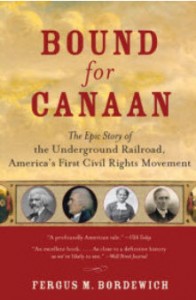 The Underground Railroad (UGR) was a loose network of individuals and households that assisted in the escape from slavery of tens, probably hundreds, of thousands of fugitive slaves during the period of 1800 to 1862. Along with Vigilance Committees, established in New York and Philadelphia and other cities after 1837, the UGR was the clandestine, direct action component of the abolitionist movement, which got its largest impetus in 1831 with the publication by Boston’s William Lloyd Garrison of a newspaper, The Liberator, and by lecture tours featuring fiery preachers and, beginning in 1841, such fugitive orators as Frederick Douglass.
The Underground Railroad (UGR) was a loose network of individuals and households that assisted in the escape from slavery of tens, probably hundreds, of thousands of fugitive slaves during the period of 1800 to 1862. Along with Vigilance Committees, established in New York and Philadelphia and other cities after 1837, the UGR was the clandestine, direct action component of the abolitionist movement, which got its largest impetus in 1831 with the publication by Boston’s William Lloyd Garrison of a newspaper, The Liberator, and by lecture tours featuring fiery preachers and, beginning in 1841, such fugitive orators as Frederick Douglass.
Bound for Canaan is a riveting account of the UGR from 1800 onward that reads like a novel focused on a nearly Tolstoian cast of characters engaged in both clandestine and public advocacy efforts to end slavery and help individuals to escape from it. During the first decade of the nineteenth century, the UGR network consisted largely of Quakers, and the book follows a number of them through three or four decades. (A few of these were genuinely free from race prejudice, but many more combined their vigorous opposition to slavery with personal distaste of Blacks and opposition to miscegenation.) The next three decades were the peak of evangelizing movements, among Methodists, Presbyterians, Baptists and others, and brought numerous whites and as well as free Blacks and some slaves to a recognition that slaveholding was un-Christian. Although most of their co-religionists remained wedded to biblical “justification” of slavery, a good many were motivated to courageous and persistent direct action against it, and became major figures in the UGR.
Prior to reading Bound for Canaan, I would have been hard pressed to recognize any Black leadership in the UGR other than Frederick Douglass and Harriet Tubman. This book makes clear the extensive leadership in the clandestine movements (UGR and the Vigilance Committees) of Blacks, both “free” and fugitive, and shows the extraordinary risks they faced. Slavery was not fully ended in New York State until 1827, and the prevalent attitude of white Northerners was pro-slavery or at least tolerant of slavery and hostile towards abolitionists. The dominant political party in New York, then called the Democratic Party, was outright pro-slavery, and its thugs participated in breaking up an 1831 anti-slavery convention of 600 delegates in Utica, NY.
Bound for Canaan provides a telling account of the political atmosphere confronting anti-slavery advocates during the lead-up to the Civil War (pp.194-95):
Many white abolitionists had also given up hope that gentle admonition would convince slaveholders to relinquish their human property. Despite decades of appeals to Christian morality, the number of slaves in the United States had steadily increased to just under two and a half million by 1840, more than double the figure at the beginning of the century. The political landscape offered only unpalatable alternatives. Neither of the major parties showed the least sign of being willing to challenge slavery’s overwhelming power in Washington. Abolitionists had only contempt for President Martin Van Buren. As Andrew Jackson’s vice president, Van Buren had provided the tie-breaking vote in the Senate that prohibited postmasters from delivering any abolitionist literature where it was prohibited by state law, and in his own 1937 inaugural address he had blamed mob violence on abolitionists’ “reckless disregard for the consequences of their actions.” Van Buren’s Whig opponent in 1940, William Henry Harrison, as a member of Congress had voted to introduce slavery into Illinois, and he publicly asserted that in his opinion the constitutional guarantees of freedom of speech and the press did not apply to abolitionists. Into this vacuum Gerrit Smith and his upstate New York supporters that year launched the Liberty Party, the first political party in American history to advocate the immediate abolition of slavery, its only platform. Its nominee for president was James G. Birney, a former Kentucky slave owner who had become converted to abolitionism.. . . Although the Liberty Party won only about 7 percent of the vote that year, and would never win much more than that, it would serve as the main national channel of political action for abolitionists throughout the 1840s. It also represented the first crucial step in forcing slavery onto the nation’s agenda, a process that would finally be complete with the founding of the Republican Party in 1856. Those who dared to vote for Birney did so at their peril. In Cincinnati, for example, one Samuel Ogden cast his vote at the Cheviot Hotel, and was instantly attacked by pro-slavery men who beat him senseless and trampled him in the mud.
Bound for Canaan interweaves its exciting accounts of slave escapes and UGR activity – both of successes and disasters – with realistic glimpses at the outrages of slavery and of the 1793 Fugitive Slave Act, leaving no room for the concept of “benign” slavery. It also provides cogent analysis of the political “compromises” that enacted the draconian Fugitive Slave Act of 1850 and shows how rescues from northern jails of recaptured fugitives by Vigilance Committees mobilized enough northern opinion against the Act to render it unenforceable in parts of the North. During the 1850s, opinion on slavery became increasingly polarized.
Certain railroad companies were led by antislavery men and facilitated the passage of fugitives as a matter of policy. . . . The fact that fugitives could travel openly with relative safety by train was another indication of the broad shift that was taking place in public opinion. By the middle of the decade, the “underground” was no longer a clandestine phenomenon in much of the North, but an open part of local life. When the Supreme Court issued its infamous Dred Scott decision, in 1857, removing all existing territorial restrictions on slavery, members of the underground, and for that matter most in the North, expressed dismay, but in practice simply ignored it. (Pp. 409-410.)
Meanwhile, the position of the South further hardened as a result of John Brown’s attack on the arsenal at Harper’s Ferry. (Brown’s quixotic expectation was that his attack would mobilize and arm a thousand slaves in support of his effort to open a safe passageway for slaves to escape the Deep South, protected along the way by armed abolitionists.) The 1860 election of Abraham Lincoln provoked the immediate secession of the first two states to establish the Confederacy. But attitudes towards slavery (even among many Northerners) would not change except as an exigency of the Civil War.
I cannot recommend the Bound for Canaan more highly. Its 439 pages have all the excitement of a good mystery novel, and a 16-page centerfold of daguerreotypes and paintings of some of the main characters and places, with commentary, provides a quick review of the text. The scholarly integrity of the book is revealed in 61 pages of notes, a selected bibliography of some nineteen pages, and a 20-page index. It has been described as the most comprehensive work on the Underground Railroad in the past 100 years. The only faults I have detected is that the end notes are not referred to within the text, and not every quote is explicitly referenced. I would also have welcomed a graphical timeline showing at a glance the sequence of the UGR events recounted in the context of political events.
Reading this book and attending the fifth annual conference of the Underground Railroad History Project of the Capital Region has raised some interesting challenges to my thinking. The direct actions of the UGR and the Vigilance Committees were the most extensive defiance of (“unjust”) laws, of civil disobedience in American history. What was, and what was not achieved by the abolitionist movement of the first six decades of the nineteenth century? What is the applicability of such broadly supported radical challenges to government to the present threat of nuclear holocaust?
As Bordewich shows, the abolitionist movement changed a lot of minds about the legitimacy of slavery. The UGR specifically provided significant models for Harriet Beecher Stowe’s influential novel, Uncle Tom’s Cabin, which in turn affected many minds. The organized Northern response to the 1850 Fugitive Slave Act and to the 1857 Dred Scott decision heightened the polarization between North and South and paved the road to the Civil War. At least some of the remaining Northern pro-slavery sentiment gave way to an acceptance of the 1863 Emancipation Proclamation, if only on the basis of soldierly obedience. Yet it is clear that the mind change among Northerners was not deep enough to support the only alternative to the Civil War that could have put an end to chattel slavery. The abolitionist movement, with its revolutionary components, was strong enough to help create the polarization that culminated in the Civil War, but not strong enough to end slavery without war.
I ask myself, what would have happened had Lincoln permitted secession, emancipated all slaves left in the Union (with the probable loss of more States to the Confederacy), and placed a complete economic embargo on every slave-holding State? The answer, of course, is that he could not have got the support necessary for such a policy. (Had he been willing and able to do so, I believe, slavery would have faded away relatively promptly, with a far smaller legacy of bitterness and residual racism.) The men who went to war and died in huge numbers “to save the Union” would not have been as prepared to end slavery by peaceful means and boycott. And, after the war and a short period of Reconstruction, they proved unready to resist the compromises that brought Jim Crow, lynchings, and a virtual re-enactment of slavery. Even today, that same tolerance for domination leaves us with the world’s greatest prison population, disproportionately Black, and for the exploitation of labor – immigrant, native, and foreign.
Could the revolutionary thrust of the clandestine anti-slavery movement be applied to present moral challenges and threats to human survival? The moral evil then was that economic “necessity” trumped human values and treated absolute domination – slavery – as acceptable. The civil disobedience of the UGR and the resistance of the Vigilance Committees helped many individuals to escape from slavery and served as a morally saving grace. Can a similar resistance change minds and emancipate humanity from the moral evil of torture, modern warfare (with its murderous consequences, and the danger of nuclear annihilation)? Can it end the practice of imperial economic domination by our corporations over the people of other nations? Can we live with ourselves accepting these evils, without resistance?
I am deeply grateful to Fergus Bordewich for his painstaking research and his lucid and compelling writing. Bound for Canaan brings to life the majority complicity in the protection of slavery and the incredible courage and skill of the resistance to it. I regard the Underground Railroad as a saving grace in much the same way I see the handful of Europeans who saved even a small number of Jews from extermination during the Nazi era: the history of that time would have been even more unbearable without their example that human goodness is possible.
Whether the author intended it or not, the story of UGR can serve as an inspiration, and perhaps as a model, for how we might confront a similarly complicit government and anaesthetized electorate in the equally great moral challenges of the present day.
